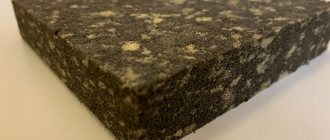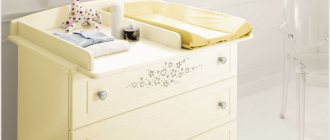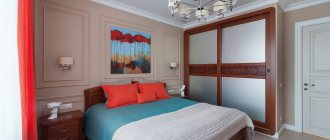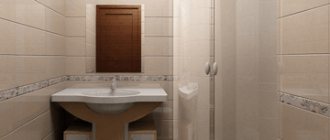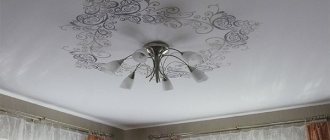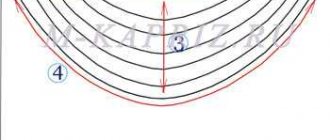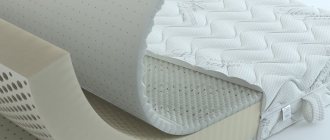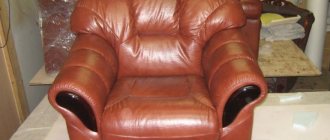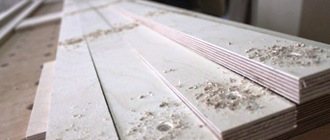When choosing upholstered furniture, it is important to pay attention not only to the external component of the product, but also to the filling. To avoid having to replace materials during operation, you need to choose high-quality foam rubber for furniture, which will serve for a long time and delight you with its elasticity.
The material is polyurethane foam, which consists of many cells filled with air. The raw material is used to impart elasticity to furniture items.
Many users choose this particular filler as an internal component of sofas and upholstered chairs. This distribution is due to the following advantages:
- No additives or processing mixtures are used in the production of the material, which means that furniture foam rubber is safe for humans. It does not emit substances harmful to health and does not cause allergies, so it can be safely used for furniture in a children's room;
- polyurethane foam is not affected by fungus, because it is moisture resistant. Even with high air humidity in the room, the chances of mold spores appearing are negligible;
- The material can be used in different temperature conditions and differences in indicators. Foam rubber retains its qualities in the range from -40 to +100 degrees;
- compared to other materials, the filler has improved soundproofing properties, due to which it is able to absorb noise;
- foam material has high elasticity and at the same time elasticity. It bends under the weight of a person, but also easily restores its shape after some time.
An undeniable advantage of raw materials is their affordable cost. It is thanks to this indicator that all upholstered furniture, for which foam rubber is used as a filler, has a budget price.
Like any other material, foam rubber has a number of disadvantages, including:
- short service life: up to 7 years of daily use;
- When the material burns, hazardous substances are released into the atmosphere.
Kinds
The material is widely used in furniture production. Due to these properties, foam rubber is popular for making chairs and mattresses. The resulting products have not only high elasticity, but also an attractive price. Depending on the purpose of the material, it is more expedient to divide it according to density indicators:
- standard brands - made on the basis of a base polyol, this is the only type of foam rubber using one type of polyol in its composition. For other subtypes of material, at least two variants of the substance are used, which give the filler different properties. This foam rubber has found its application in the equipment of armrests and headrests. Its average density is 25-30 kg per cubic m;
- material of increased rigidity - for the production of such raw materials, special polyols are used, which give the product special properties of rigidity. The density of the compositions depends on the additives. If the material has a density of up to 30 kg per cubic meter, it is used in the manufacture of seats and mattresses. If the characteristics exceed the specified figure, the raw material is suitable for the production of furniture with high loads;
- highly elastic material - the density of highly flexible foam rubber exceeds 30 kg per cubic meter; products made from such raw materials can withstand a weight of 120 kg. This type is widely used in the manufacture of mattresses.
In addition to the listed types of foam rubber, soft and supersoft compositions should be distinguished. They are made from polyurethane, endowed with softening properties. Also, in the manufacture of raw materials, special additives can be used to obtain non-flammability and a viscous structure. In this case, melamine, fire retardant and special polyols are used.
Why is it important to use molded polyurethane foam?
To produce theater furniture, you need polyurethane foam made by molding, and for the latter, molds with high dimensional accuracy, made to individual measurements, after which the material does not require cutting.
You can make such a mold to order, based on the parameters of the furniture that is in production. Orthopedic pillows, soft parts of sofas, armchairs, and beds with high orthopedic properties are also made from molded polyurethane foam. To fill such parts, entire complexes are needed, which necessarily include pumping stations, filling heads, manipulators, sets of consumable containers, control panels and hoses. The purchase of such a complex with molds is an important investment in a production facility specializing in the production of serial upholstered orthopedic furniture with high performance properties.
Quality indicators
To understand the quality of the material with which furniture is filled, it is important to know the main characteristics by which it is determined. These include the following indicators:
- density;
- strength;
- compressive stress
- markings;
- elasticity;
- permanent deformation;
- degree of comfort.
Each of the listed criteria needs to be considered in more detail. As already mentioned, the density of the material determines its purpose. The higher this indicator, the greater the load the material can withstand on furniture and the longer its service life.
The strength criterion is represented by two characteristics: tensile strength and the degree of elongation of the material before this fracture. With a density of 25 kg per cubic meter, this figure will be equal to 130 kPa (tensile strength) and about 260 percent elongation.
The compressive stress of a material indicates how much force must be applied to compress the sample. Rigid varieties of foam rubber are sometimes artificially equipped with strong compression to improve performance, but when the cells with air are opened, the material returns to its structure.
Foam rubber markings have a separate classification, which will be discussed in our article below. The elasticity of the raw material is determined by dropping a special test ball onto it. They throw it onto the material and check the degree of rebound: if the ball bounces high, then the foam is hard and less elastic.
To determine the indicator of residual deformation, the method of strong compression of the sample is used, which is left in this state for a while under the influence of a certain temperature and humidity. At the end of the period, the sample is measured and compared with pre-prepared standard indicators. Hard foam will have little permanent deformation.
Indicators of the degree of comfort are also represented by two designations: support coefficient and comfort coefficient. These criteria are determined by the softness of the material, as well as the distribution of the load along the plane.
Purpose of various brands of furniture foam rubber
There is a certain classification that involves the use of foam rubber of different markings in the production of various furniture. First you need to understand what a brand designation is. For this, Latin letters are used:
- ST – this abbreviation denotes standard type foam rubber;
- HL and EL – symbolize foam rubber of the hard type and the version of increased rigidity, respectively;
- HS - this is the symbol the manufacturer uses to mark soft and ultra-soft foam rubber, a furniture version that can be seen in sofas;
- HR – this is the designation for highly elastic foam rubber;
- LR – letter designation of a material that is soft and viscous in structure;
- RTC is the manufacturer's term for reticulated polyurethane foam, which is characterized by high porosity.
In addition to Latin letters, the symbolism uses numbers, the first two of which indicate the density of the foam rubber, the remaining two are responsible for the compression tension. For example, if the filler is marked as follows: EL 2545, then this will mean the following indicators:
- foam rubber of increased rigidity;
- material density – 25 kg per cubic m;
- the compressive stress is 4.5 kPa.
Depending on the marking, the purpose of the foam rubber is chosen. So, for upholstered furniture, the optimal indicators will be 30-40 kg per cubic meter in the manufacture of seats and mattresses. For children's furniture, specifications of 25 kg per cubic meter are suitable. Brand 1620 foam rubber is the softest and less durable; it is used for the production of furniture elements with light loads.
Brands 2336 and 2310 are most appropriate for teenage furniture, as they are considered durable.
They can also act as a layer for springs in the manufacture of mattresses. Marking 2536 indicates that this foam rubber is most applicable in the production of furniture. It is the most popular raw material in the domestic production of soft sofas, chairs and armchairs.
HIGHLY ELASTIC GRANDS OF FURNITURE FOAM
Highly elastic brands of foam rubber with increased rigidity are obtained using special types of polyols. These include the following brands of foam rubber:
HL (hard elastic) – dense elastic
RDB (double bubble) – secondary foaming
HR (hard rubber) – increased elasticity (artificial latex).
HL (hard elastic) – dense elastic foam rubber, the density of which exceeds 60 kg/m3. Suitable for the production of high-quality furniture and orthopedic mattresses.
RDB (double bubble) – secondary foam rubber, has a density of 100 kg/m3. This is a very hard material that is only suitable for sports mats or exercise equipment. Well, or for “yogis” - lovers of extreme sports. Secondary foam rubber is also used in the automotive industry and construction as a sound insulator.
HR (hard rubber) is highly elastic foam rubber, it is also called artificial latex. The material is relatively new to the Russian furniture market; it has a density of 30 kg/m3, increased elasticity, a high level of comfort and a long service life, which reaches up to 15 years.
Foam rubber, as a sofa filler, is one of the safest and inexpensive materials. For furniture padding, the use of foam rubber is very justified, as it has many advantages:
- does not produce dust;
- does not become moldy;
- is a hypoallergenic material;
- retains its original shape well during use;
- does not lose elasticity when exposed to high temperatures.
Solid foam rubber or its pieces left over from the production of other, higher quality furniture are used as sofa filler. Using solid foam rubber to stuff a sofa is the best option, since furniture filled with foam rubber waste quickly deteriorates.
Sometimes foam rubber for a sofa is used together with other filling materials, for example, with spring blocks. Thanks to this combination, the furniture lasts longer.
During use as a furniture filler, foam rubber is subjected to loads a huge number of times, which gradually leads to the loss of its properties, and, consequently, to wear and tear of the furniture. To restore the comfort of worn-out furniture, the foam rubber in the sofa is replaced.
Which foam is better for a sofa?
The new foam rubber should not be inferior in quality to the material that originally filled the sofa. But among the variety of furniture fillings, it is very difficult to decide which foam rubber is best to choose for the sofa. And the range of prices for them can completely drive you into a stupor. Therefore, when choosing foam rubber, first of all, you need to pay attention not to the price, but to its main characteristics - the thickness and density of the material.
To make it comfortable to sit and lie on the sofa, and not to sag over time, you need to choose a material with a density of at least 30 kg/m3, this is the density that is typical for high-quality foam rubber used as filling for the sofa. The higher the density of the filler, the longer the furniture will last. At the same time, the density of the foam rubber used as a filler for the back and armrests may be lower than that of the seating material.
The thickness of the foam rubber used in a sleeping sofa should be at least 4 cm, although furniture manufacturers often try to save money and use a filler 2-3 cm thick.
Its markings help determine what density the foam rubber has, where the letters indicate the brand, the first two numbers indicate the density, and the last ones indicate the hardness, which for a sofa filler should be about 40 units.
Where to buy and approximate prices for foam rubber
The cost of foam rubber for filling furniture directly depends on the thickness, density and quality provided by the manufacturing company. Construction stores where you can buy foam rubber for a sofa at prices ranging from 15 to 550 UAH. per sheet of 1x2 m, they offer a wide range of this material. Foam rubber scraps will cost 2-6 UAH. for 1 kg, they can be purchased from furniture manufacturers directly at their warehouses or websites.
Replacing foam rubber in a sofa
Replacing foam rubber in a sofa consists of several stages:
- disassembling the sofa into its component parts;
- removing upholstery;
- removal of old filler;
- pattern making;
- attaching new foam rubber to the seat, back, sides;
- reupholstery of component elements;
- assembly.
When replacing the filler, you should follow some rules:
1. Old foam rubber must be removed completely and together with the staples.
2. The pattern is made taking into account the allowance (7-8 cm) on the inside of the component element of the sofa. Allowance is made only for those places where the foam rubber exits to the inside is provided, otherwise the sofa will be impossible to assemble or unfold.
3. Before attaching the foam rubber to the seat, a dense fabric is laid on the spring block, which is grabbed in several places with a strong thread.
4. Foam rubber is placed on the seat in two layers.
5. The foam rubber attached with staples is completely covered with canvas fabric to increase the comfort of the furniture.
We also recommend:
Comments:
Facebook (X)
VKontakte (0 )
Regular (5)
- Rita
Several years ago we bought a sofa at the Megaroom store. Now I already want some new things. Unfortunately we can’t do it ourselves, we’re thinking of covering it with fabric. Is there such an article on the site?
When choosing upholstered furniture, it is important to pay attention not only to the external component of the product, but also to the filling. To avoid having to replace materials during operation, you need to choose high-quality foam rubber for furniture, which will serve for a long time and delight you with its elasticity.
The material is polyurethane foam, which consists of many cells filled with air. The raw material is used to impart elasticity to furniture items.
Many users choose this particular filler as an internal component of sofas and upholstered chairs. This distribution is due to the following advantages:
- No additives or processing mixtures are used in the production of the material, which means that furniture foam rubber is safe for humans. It does not emit substances harmful to health and does not cause allergies, so it can be safely used for furniture in a children's room;
- polyurethane foam is not affected by fungus, because it is moisture resistant. Even with high air humidity in the room, the chances of mold spores appearing are negligible;
- The material can be used in different temperature conditions and differences in indicators. Foam rubber retains its qualities in the range from -40 to +100 degrees;
- compared to other materials, the filler has improved soundproofing properties, due to which it is able to absorb noise;
- foam material has high elasticity and at the same time elasticity. It bends under the weight of a person, but also easily restores its shape after some time.
An undeniable advantage of raw materials is their affordable cost. It is thanks to this indicator that all upholstered furniture, for which foam rubber is used as a filler, has a budget price.
Like any other material, foam rubber has a number of disadvantages, including:
- short service life: up to 7 years of daily use;
- When the material burns, hazardous substances are released into the atmosphere.
Selection rules
Before choosing a filler for upholstered furniture, it is important to decide what kind of product it is. If foam rubber is selected for a sofa, pay attention to the markings with density indicators from 28 kg per cubic meter and higher. If you purchase less dense material, there is a risk that the sofa will not last long.
- check the thickness of the foam; for upholstered furniture it should be at least 3 cm;
- find out about the rigidity and elasticity of raw materials: a stiffer option is suitable for seats than for filling headrests or armrests;
- some types of foam rubber do not hold their shape at all, which indicates their low quality, so check this criterion in the store to make sure the reliability of future furniture;
- ask what additives were used in the production of raw materials to prevent allergies to certain substances, especially when it comes to children's furniture.
Pay attention to the markings; they will help tell you a lot of information about the chosen foam rubber. You should not save on filler, because high-quality material is the key to a long service life of furniture.
It's time to replace the filling for the sofa and you don't know which one to choose? We recommend sticking with foam rubber. This material is one of the safest and cheapest sofa fillers. In this article we will tell you how to choose foam rubber for a sofa and how to replace it.
What is it suitable for?
This foam is best used in the manufacture of backs. These can be pillows, headboards and wall panels. In a word, all those places that are not loaded very much. If you're on a tight budget, it's also a good choice for seat cushions. Especially if there are a lot of pillows.
Chair seats are made from this foam. He does his job well. And this same foam rubber can be used as a soft layer in low- and medium-cost mattresses. When we ask customers why the choice was made in favor of this foam rubber, most answer that they were guided mainly by savings.
Why you should choose foam rubber for a sofa
Foam rubber has many positive features, such as:
- able to not produce dust or become moldy;
- is a hypoallergenic material;
- retains its shape well during use;
- under the influence of high temperatures its elasticity remains the same.
You can use foam rubber whole or only its pieces, which can be preserved from the production of higher quality furniture. It is better to use solid material as the stuffing of the sofa, since previously used pieces may become unusable sooner. In order for the furniture to last longer, foam rubber can be combined with other fillers, such as a spring block.
If furniture is used frequently, such filler may lose its properties due to heavy load and the furniture will look worn out. In order to return it to its former convenience and comfortable use, it needs to be replaced. This filler is distinguished by hardness, elasticity and density. The density of foam rubber affects its service life and, accordingly, its quality. In order to determine the level of rigidity of the material, it must be squeezed tightly.
In the furniture industry, standard foam rubber (ST) and increased rigidity (EL) are often used. The standard one has a density of 25 kg/m3 and its rigidity is comfortable. In order to determine the density and hardness of a material, you need to look at its brand, for example ST3542, where the first two digits indicate its density, and the last two indicate its hardness index. This material will last at least 10 years.
For furniture with expected loads of 90-100 kg. they use foam rubber of increased rigidity, for example brand EL2240, which is the most common today due to its optimal price-quality ratio. It is used as a filler for inexpensive furniture with a service life of no more than 5 years, as well as for children's mattresses.
EL2842 has a longer service life and can be used for up to 10 years. It has greater rigidity and is suitable for sofas, sleepers, office chairs and so on. The density of 30 kg/m3 will allow you to sit or lie on it comfortably and comfortably; it will also allow the material not to sag for a long time.
If you want the furniture to last longer, then the density of the filler should be higher. It is worth noting that the density of the material used for the armrests and backrest may be lower than that for what will fill the seat. For a sofa that will be used as a sleeping place, the thickness of the filling should be at least 4 cm.
The cost of filler, like any other product, depends on its quality. Foam rubber for a sofa can be bought in construction stores, and you can find pieces of it from furniture manufacturers either in their warehouses or in online stores.
Brands of foam rubber and its main characteristics
Any furniture requires high-quality and optimal filling, be it a spring block that helps create reliable seats and sleeping areas, or soft filling for armrests and backrests. Not paying due attention to such materials means depriving yourself of the pleasure of using comfortable and beautiful furniture. To be confident that you are making the right choice among the abundance on the market, you must have at least a superficial understanding of this or that type of filler. So, let's talk about foam rubber or, as it is more accurately called, polyurethane foam. Often, among various types of furniture-related information, one encounters the name not only of foam rubber and polyurethane foam, but also the abbreviation of the latter - PPU. Essentially, all of this is the same thing. No matter how furniture experts call this material in their notes and articles, we are talking about foam rubber, which is well known to everyone. Another thing is that this filler, known even to a child, is not as simple as it seems. This is because it has a considerable variety of varieties and is characterized by a certain set of properties that can differ radically from each other. It is these properties that influence where and how it should be used.
Main characteristics of polyurethane foam as quality indicators
The properties of polyurethane foam, on which its physical and mechanical characteristics depend, include: density, rigidity, tensile strength, residual deformation, air permeability, elasticity, elongation, cell size, support and comfort coefficient. The last two values are used mainly for highly elastic grades of polyurethane foam. These indicators determine how long the polyurethane foam will be used, how comfortable a particular surface of a furniture product will be, and even how “breathable” a sleeping place created using a specific type of polyurethane foam will be. To get to the heart of the matter, let's look at a few key properties.
Density
Perhaps the most basic parameter, which largely determines all the others. The density of polyurethane foam also affects its service life. As a rule, the higher it is, the longer the PPU lasts. This is explained by the fact that due to the larger amount of substance per unit volume, brands with higher density do not lose their original size and rigidity so quickly; they are better able to withstand long-term static and dynamic loads. In simple terms, density is the amount of foam rubber per unit volume, i.e. a value indicating how many kilograms of polyurethane foam are per 1 cubic meter. It is often confused with rigidity, but this is not correct. Although these two indicators are interconnected, they are not as clear as it seems at first glance. Softer foam rubber can have even greater density than hard foam. However, in fairness, it should be noted that density still determines the lower and upper limits of PU foam rigidity, which can be achieved for a given density value within one foam class.
Rigidity
No less significant indicator. Stiffness is characterized by the value of the so-called “compressive stress” - it shows how much pressure must be applied to the foam in order to compress it by 40%. For soft furniture parts, types of foam rubber with the required stiffness value are selected, often taking into account the future load on the product.
Permanent deformation
This is also one of the key indicators of the quality of furniture foam rubber, allowing one to judge how well it is able to maintain its size and shape during use. To determine the value of this indicator, a test sample of polyurethane foam is compressed by 50% and left there for a certain time in a room with a specific temperature and humidity. After removing the load, determine, as a percentage, the amount of deviation of the sample from its original dimensions. It is clear that polyurethane foam with a high rate of residual deformation should not be used for the manufacture of sleeping surfaces and furniture seats.
Types or brands of foam rubber
In order not to make a mistake with your choice, and to choose the right filler for furniture, it is worth remembering that it is divided into certain brands. The list of these brands of polyurethane foam includes more than ten varieties, including special fireproof ones, for household use, and secondary foamed polyurethane foam. However, only about five species are especially widely used. We'll talk about them now.
Standard Grade (ST)
A simple brand, which is produced on the basis of one base polyol and is considered the “foundation” for other brands of polyurethane foam. It is marked, respectively, with the symbols - ST and is characterized by the dependence of rigidity on density. It is used both for packaging and creating decorative elements, and for the manufacture of backrests, armrests, headrests, as well as for seats and berths, taking into account the expected load.
Brand of hard foam rubber (HL) and foam rubber with increased rigidity (EL)
Produced using special types of polyols. In fact, this is a modification of the ST brand, which, with the same volume as it, has greater rigidity. It is often used to make mattresses and seats, selecting the required density and rigidity depending on the expected loads.
Soft and ultra-soft grades of foam rubber (HS)
This type of foam rubber is produced using a special polyol, which softens the foam. It is most widely used for the manufacture of furniture backs and as a covering layer for mattresses.
High elastic grade (HR)
Produced using two or three types of special polyols. This brand of polyurethane foam has a high level of comfort, which combines low initial rigidity and quite impressive load-bearing capacity. It is thanks to such unique properties that this brand of foam rubber is used for the manufacture of expensive, high-quality furniture as filling for sleeping places and seats.
Any polyurethane foam is usually labeled by type, density and hardness. For example, ST3542 means: standard foam rubber, density - 35 kg/m3, hardness - 4.2 kPa. In conclusion, I would like to note a few more nuances. It is also important not to forget that polyurethane foam with a density below 25 kg/m3 has long been used everywhere exclusively as packaging material, and therefore, when using it in the manufacture of furniture, one should not expect high levels of comfort and durability. It would not be amiss to mention the principle of multi-layering, which is often used by manufacturers of high-quality furniture: on the bottom they use a brand of polyurethane foam with a high coefficient of support, and on top - as a flooring, a brand with a high coefficient of comfort. In a word, no matter what you have in mind and no matter what furniture dreams you decide to bring to life, taking into account the above-mentioned “simple truths”, it will be much easier to implement your plans. The main thing is desire and imagination, and the “right” polyurethane foam will not keep you waiting!
How to choose foam rubber for a sofa
For different types of furniture, you can choose different foam options:
- Sofa-sofa. A budget option for seat filler could be the EL2240 brand. But if you are interested in a harder and more durable filler, then it is better to stop at EL2842. In order to supplement the spring block, you will need to purchase a solid sheet of foam rubber having a thickness of 3-4 centimeters. Felt, which should be placed on the springs, can increase the service life of such furniture and protect the foam filling from the action of springs. Its density should be 800 g/m2. If foam rubber fills the entire soft part of the furniture, then you should choose the EL2842 or ST3542 brand, which has a thickness of at least 10 cm. For a sofa with a standard soft sleeping place, whose load does not exceed 90 kg, you can use the ST3542 brand. For the remaining parts of the sofa, you can use a different brand of filler.
- Sofa book. This type of sofa can be made using foam rubber alone or in combination with a spring block. Since their design resembles a sofa, the same brands of fillers can be used here.
- Corner sofa. This sofa has different transformation mechanisms and designs. In order to ensure the comfort of furniture that has a “sedaflex” mechanism, which is a soft part that can be called a set of pillows, you should choose ST3542 brand foam rubber. The thickness of the mattress of a sleeping place with such a mechanism usually does not exceed 10 cm. In order to replace the mattress filler, you should use EL2842 foam rubber for a hard sleeping place or ST3542 for a standard one. To replace a sagging seat in a sofa with a “dolphin” mechanism, you should use a material 8-10 cm thick, its density should not be lower than 25 kg/m3. For an economical option, you can choose the EL2540, but we recommend the higher-quality EL2842 or the softer ST3542.
- Sofas for guests. Guest sofas can be equipped with different mechanisms for transforming into a sleeping place. Foam rubber is suitable for them as for corner sofas or furniture with “dolphin” or “sedaflex” mechanisms. Which brand to choose depends on your financial capabilities.
- Kitchen Area. To repair a kitchen corner in a kitchen made of chipboard or with a wooden frame, it is recommended to use a filler 2-3 centimeters thick of the EL2842 brand, and for a soft corner you can use a material 4-6 centimeters thick of the EL2842 or ST3542 brand.
Polyurethane foam brands
When considering the options for which foam rubber to choose for furniture, first of all pay attention to the brand of the proposed material: it determines the main indicators, and the numbers that follow clarify the information (density and hardness):
- ST – standard, produced on the basis of standard polyol, used as a filler in the manufacture of upholstered furniture, chairs, armchairs, decorative walls;
- HL, EL – hard and the hardest, ST modifications with increased rigidity, used for seats and mattresses with expected increased load;
- HS – soft, ultra-soft, made from a special polyol, used for backs and mattress underlay;
- HR – increased elasticity and comfort, used for the production of luxury furniture.
There are several more varieties (RTS, RL, VE, secondary foam rubber), and the list is constantly expanding.
How to choose foam for a sofa
If you need to replace the filling in a sofa, consider a few nuances:
- the material must be at least 3 cm thick;
- density – from 28 kg/m³ and above;
- indicators of rigidity and elasticity (in the marking).
High-quality material is not too cheap - so stick to average prices and choose reliable manufacturers.
Which foam rubber to choose for the sofa will depend on the type of furniture:
- Sofa. A budget option is EL2240, but when used as a bed, buy material with increased density and rigidity, 10 cm thick.
- Angular. To replace the filler, choose the ST3542 brand; if you need increased rigidity, choose EL2842.
- Sofa for guests. The type of filler depends on the frequency of use as sleeping places and your financial capabilities.
For other types of furniture, the recommendations are approximately the same: a budget option is ST brand foam rubber; when restoring, take material with enhanced characteristics.
Which foam rubber to choose for a mattress
There are 2 main brands used in the manufacture of mattresses:
- ST – standard offer;
- EL – increased rigidity, service life up to 10 years (at high rates).
How to replace foam rubber in a sofa
Having chosen a suitable filler, it needs to be replaced. Below we will tell you how to change the foam in a sofa with your own hands. First you need to figure out what work needs to be done: re-upholster the entire sofa or replace only the foam. Take a good look at the furniture and evaluate how worn the filling is in different places. Most often, depression occurs in the seat, but let's assume that you need to replace the sofa in all areas.
To do this, you need to remove all its elements from the furniture. We recommend capturing the disassembly process in a photo or video - this will make it easier to put everything back together. Then, if possible, remove or open the upholstery and remove the old foam. In addition to it, there may be other elements, such as felt or padding polyester, which should also be replaced, so take this into account in advance.
Sometimes manufacturers provide seats and cushions with zippers to make it easier to change the filling. But if they are not there, then you will need to rip out the seams and then sew them back together. To remove elements on a plywood backing, such as the back, you will need to remove the fastening elements. This can be done using an anti-stapler.
After removing the upholstery material, you need to take out the old filler and use it to pattern a new one. After cutting out new sheets, place them in place of the old ones and secure with new fasteners. The upholstery material can first be sent for cleaning and stains, if any, can be removed. Next, we put the upholstery back in its original place. To make it tight, you should press firmly on the foam while attaching the upholstery to the base - this will help it straighten out when the upholstery material is in place, and will add elasticity to the seat. After repeating the process with the remaining parts of the sofa, you will need to assemble it to its original state.
Now you know how to choose the right foam rubber and replace it in the sofa with your own hands. All that remains is to go to the store for a new filler.
Foam filling plays an important role in the production of upholstered furniture. The comfort of relaxation and the service life of the product depend on its quality and correctly selected parameters. Experts will help you decide which foam rubber is best for the sofa.
How to make a foam bait
Foam rubber is probably the only full-fledged bait that, if necessary, can be quickly made right while fishing, if suddenly, unexpectedly, the supply of “fish” has run out. To do this, I take scissors or a sharp knife, and from a piece of sheet foam rubber 1-1.5 cm thick, I cut blanks 6-10 cm long. On each I make a longitudinal cut half the thickness, and into this cut I insert a double hook on a wire loop, its length is as follows so that the hook points are located approximately in the middle of the body of the bait, and the front eye of the loop extends slightly at the head of the bait. The cut is sealed or simply melted, and through the winding ring I connect the foam rubber with a spherical sinker - “Cheburashka”, in front of which I place a metal leash - that’s it, the snag is ready.
An important point - loading
Firstly, it must clearly correspond to the depths in the fishing area; secondly, it is useful for the lead to be tarnished, on which pike perch and pike leave light scratches with their teeth, and if you regularly inspect the load, it is clearly noticeable where there were very careful bites, what kind of fish is showing interest in the bait, and to deal more persistently fishing these points.
The foam rubber itself can be painted, or you can leave the natural color as it is for this material, in my opinion, in most cases it makes no difference to the predator. You can cut out a beautiful fish with a tail that looks like a living prototype, or you can just make a cigar-shaped stump - even this moment does not affect the bite. Indeed, in any case, the foam rubber practically does not have its own play, passively following in the direction of stretching. Or just regular stops in different variants of jig wiring perfectly provoke the same pike perch to attack.
Density
This is the most important characteristic of a material that affects its durability. The cost directly depends on it: the denser the foam rubber, the more expensive it is. The range of material densities is from 18 to 55 kg/m3.
What density of foam rubber is needed for a sofa? To do this, you may need material of different densities (kg/m3):
- 18 – used in not very important important parts (drawbars, backdrops);
- 20 – used for making backrests and backrest cushions;
- 25 – suitable as a load-bearing layer of seat padding;
- 30-35 – optimal as a load-bearing layer of seats with increased weight;
- 40 – the use of a material of this density makes the furniture almost “eternal”, suitable for long-term intensive loads;
- 50 – the indicated density is used in special brands of foam: viscoelastic (Memory Foam), highly elastic (latex). This material provides maximum comfort due to anatomically correct body position.
The minimum recommended values of foam rubber for seats are from 25 kg/m3. This durable material is suitable for everyday use, occasionally for sleep. For a product intended for everyday sleep of adults of average build, it is better to choose an option with a density of 25-30 kg/m3, for overweight people - 35 kg/m3.
STANDARD GRADES OF FOAM RUBBER for furniture upholstery
Standard brands of furniture foam rubber are produced using one basic component - polyol and have general quality indicators, which include: density, compression resistance, strength, elasticity, residual deformation, comfort.
The most important characteristics of furniture foam rubber listed are density and compression resistance. It is these values that are reflected in the marking of the material.
Thus, letters and numbers are used to designate foam rubber brands. The letters indicate the class of the material, the first two numbers indicate its density (the higher this number, the stiffer and more durable the material), the second two indicate the compression resistance.
For standard brands there is the following letter gradation:
ST – standard
EL – elastic
The ST designation includes polyurethane foam with a density of up to 25 kg/m3 and a hardness of up to 3.4-3.5 kPa. Foam rubber of brands ST 2030, 2236, 2536 is suitable only for decorative pillows. Brands ST 2236, 2536 are used to upholster the backs of sofas and armchairs, as well as armrests. They can withstand loads of up to 50 kg.
The letters EL indicate that the density of the material exceeds 25 kg/m3 and reaches 60 kg/m2. This type of foam is used for the manufacture of seats for sofas and armchairs, and for the production of mattresses.
As an example, consider the EL 3040 brand. The designation is deciphered as follows: EL – increased rigidity brand, 30 – density 30 kg/m3, 40 – compression resistance 3.5 kPa.
To find out what density of foam rubber is needed for the manufacture of a particular piece of furniture, you need to imagine what permissible load it will be designed for. This can be clearly seen from the table below.
Table of required foam density
Rigidity
The stiffness index determines the pressure at which the material is compressed by 40% relative to the original thickness. It determines the scope of application of the material. soft and super-soft grades can be used for sofa parts that are subject to less pressure, but require significant deformation (back cushions). Standard ones are used for the manufacture of standard parts, for example, seat cushions, and rigid and increased rigidity ones are used for office furniture and the shaping of upholstered furniture elements.
Where to buy sofa filler?
The staff will help you decide what kind of foam rubber is needed for the sofa. We offer only high-quality products of our own production at the most competitive prices. The range includes more than 900 items of fillers, fasteners, and related products. Convenient, fast delivery throughout Moscow and the region. Call!
Which foam rubber to choose for your sofa depends on what your intentions are. If your furniture will be used as a permanent place to sleep, you need to choose a harder filling. After all, for medical reasons, the bed cannot be too soft. If people will sit on this furniture most often, and will only have to sleep sometimes (for example, guests who have stayed too long), then how hard the foam rubber will be is not particularly important.
Important nuances
The best sofa
- one where soft and elastic foam rubber was used, allowing you to relax and give the spine the opportunity to rest from stress. This effect is achieved using a special structure - a “layer cake”. This is when the upper part is thin foam rubber with low density and rigidity, and underneath there is a more elastic material. Such a sofa resembles a tire that is moderately inflated - there is no lethargy, but there is elasticity and firmness, which does not turn into rigidity. However, furniture “filling” includes not only foam rubber and blocks of springs. They also use synthetic fibers, most often synthetic padding polyester. As a rule, foam rubber is covered with padding polyester, thereby achieving additional softness and relief. At the same time, it serves as insulation for the main filler. The “filling” for a sofa of expensive brands consists of highly elastic foam rubber and latex of natural origin.
profiled foam rubber
foam blank
latex for furniture
There is an opinion that nothing can be better than spring sofas, that the orthopedic effect cannot be achieved otherwise. However, customer reviews indicate that often these same springs turn out to be of such poor quality (incorrect hardening is sometimes to blame) that they fail in a short time. Several layers of felt blanket, as well as other materials, are laid on top to make the spring mattress really high quality. This pleasure is not cheap, and therefore we can assume that it is better to use high-quality foam rubber than cheap springs.
Which furniture foam is better to choose?
When choosing a sofa, you should definitely pay attention to its convenience and comfort. The filling of upholstered furniture plays a huge role, so it is worth asking what kind of foam rubber was used as the filler of the product. The variety of brands can lead to confusion, but when choosing a filler for upholstered furniture, you should not be guided by the price, since thickness and density are important criteria for choosing this material.
An excellent filler for upholstered furniture is foam rubber with a density of 30 kg/m³.
A sofa with this design is ideal for both sitting and lying. It is practical because the filler does not sag over time.
The lifespan of upholstered furniture directly depends on the density of foam rubber.
The higher the density, the longer the product will remain like new.
Typically, filling of varying densities is used for the seat, armrests and backrest. It is customary to use low-density material for armrests.
Another important criterion is thickness.
If you plan to use the sofa for sleeping, then the thickness of the filling should not be less than 4 cm.
Manufacturers do not take this indicator seriously, and to save money, they use foam rubber with a thickness of 2 to 3 cm.
To find out the density of foam rubber, you should pay attention to its marking, since the first two digits are used to indicate it. If you are looking for a hard sofa, then the last two numbers will help. Typically this figure is 40 units.
What's in the sofa "stuffing"?
If you purchase good upholstered furniture, it soon becomes an inseparable element in the interior of the room. And then I really don’t want to part with such a product. If, when choosing the most suitable sofa, you made a mistake and did not see the shortcomings, then they will also appear very soon and will regularly spoil not only your rest, but also your mood.
As a rule, when choosing upholstered furniture, people are mainly interested in its size, shape, quality and color of the upholstery material, very often completely forgetting that during use all these parameters are a secondary matter. The main thing is how soft and elastic the sofa will be, how comfortable it will be for you to relax on it.
It depends only on the filler how comfortable and cozy the upholstered furniture is, when the sitting effect occurs, and what the service life of the new sofa will be. Sofas, as a rule, have a “filling” in the form of a complex system, which includes soft components and a base of springs. How much a sofa will cost will be clear from what a person cannot see when purchasing - it is inside.
About holofiber
If these are average prices, then the “filling” consists mainly of synthetics. For a soft and resilient sofa you need:
- elastic polyurethane foam;
- non-woven high-volume components;
- block with springs;
- natural latex;
- synthetic fluff.
natural latex
block with springs
elastic polyurethane foam
When a person chooses a sofa, he evaluates it both by its density and the stiffness of the seat. They are characterized differently:
- Density refers to the weight of one cubic meter of material when it is uncompressed. As the density of the material increases, its wear resistance characteristics also increase, which means that the furniture will last much longer.
- Stiffness refers to how a material reacts to load. How comfortable a person will be depends on this.
What is the difference between foam rubber and polyurethane foam
There is no difference . PPU (polyurethane foam) is just an abbreviation
whereas foam rubber is a brand name. It was awarded the first commercial polyurethane foam.
About block polyurethane foam
We know it as foam rubber, which is a soft polyurethane foam in which 90% is air. The higher the elasticity of the foam rubber, the higher its strength. Very soft material will quickly crumble and fail. If even a simple sofa cushion is filled with foam rubber crumbs, it will lose its shape in a very short time, and therefore only a solid piece of foam rubber can be used to make a sofa. Moreover, these are not thin pieces of foam rubber; their thickness cannot be less than 15 centimeters.
When choosing a sofa, you need to sit on it to feel whether the frame is felt or not. If such sensations exist, then after a short period of time it will be impossible to sleep on such furniture.
Molded polyurethane foam
These are ready-made sofa parts. They easily return to their original shape as soon as the load is removed. This type of polyurethane foam is considered the best in terms of elasticity; it is more reliable than block foam. Sitting on a sofa with such a “filling” will be very comfortable, because it completely follows the shape of your body, and getting up from it is easier than from other sofas. It's like he's nudging you slightly.
Such qualities of molded polyurethane foam have made it very popular as a filling used in the manufacture of sofas.
About the cost
The cost of foam rubber always depends on how dense it is. The lowest density means the lowest cost. If the sofa is made by unscrupulous furniture makers, then they use greater rigidity to increase the price of the sofa with low-density foam rubber. This approach misleads the buyer - the rather dense and elastic appearance of the furniture. But then several months have passed, and you notice that the foam rubber has become confused, and then completely became some kind of shapeless mass.
You need to understand some simple rules for choosing foam rubber:
- The standard minimum density of foam rubber for furniture parts used in seats is 30-35 or more kg per cubic meter.
- For the back, this value should not be less than 23-25.
- In the manufacture of armrests, a density of at least 20-22 kg/cube can be used. m.
If these standards are not followed, the amount of residual deformation will greatly increase, and the sofa will not last long.
Varieties
Foam rubber that “remembers”
Of all the options, the most interesting is foam rubber, which has “shape memory”. It has unique physical and mechanical properties, namely, it is slowly restored after removing the load. At first, such foam rubber exactly repeats the shape of the body lowered onto it, and when the load is removed, it begins to slowly return to its original position. For a sofa, this option will be the best choice - to make your rest truly comfortable.
About latex
This material is obtained by foaming rubber. The result is a material of natural origin, reminiscent of foam rubber. It also conforms to your body, making your rest comfortable. In addition, it also has antibacterial properties.
Latex foam rubber brand HR
This is an artificial material with a high degree of elasticity. It is much cheaper than natural latex. This material has a special cell structure. If foam rubber is usually cells of the same size and with walls of the same thickness (which are deformed equally and resist compression), then the HR brand has a completely different structure. These are cells that are different in size and heterogeneous in structure. Moreover, they are scattered in a chaotic manner, and their reaction to the load is ambiguous.
At low loads, only small cells with a small wall thickness work. This is how super soft foam works. If the load is significant, larger cells with greater compression resistance are used. This technique makes it possible to experience complete comfort, which is usually not so easy to achieve.
In recent years, foam mattresses have been gaining popularity. They are light, durable, affordable, wear-resistant, and retain their shape for a long time. When choosing foam rubber for a mattress, you need to take into account two main indicators - its density and hardness. Experts will tell you about the features of selection and suitable brands.
Selecting density
It is this parameter that affects the durability of the product. The greater the load on it, the longer it is used, the denser the material you need to choose. For example, for the children's version it is better to buy foam rubber with a density of 20-22 kg/m3. For adults weighing 70-90 kg, who sleep 8-9 hours and can spend an additional 3-4 hours a day on the bed, we recommend stopping at 25-30 kg/m3. For a person weighing about 100 kg, who spends 15-20 hours a day in bed, it is necessary to make it from a material of increased density - 35 kg/m3.
Deciding on rigidity
In the manufacture of mattresses, predominantly standard, highly elastic and high-hardness foam rubber is used, since these products are intended for daily long-term use. Depending on the recommended load, we recommend choosing the following brands:
- for mattresses designed for loads up to 60 kg – S 3025, S 3035, ST 2535, EL 2240, EL 2345, EL 2540, HR 3025;
- up to 80 kg – S 4040, ST 3040, ST 2735, HR 3530;
- up to 100 kg – S 3530, ST 3545, HR 3535, HR 4040;
- up to 120-130 kg – ST 5050, EL 4060.
If the sleeper has problems with the spine, it is recommended to choose a more rigid option.
